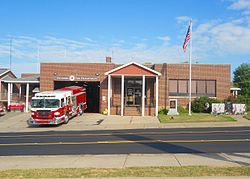Dunmore, Pennsylvania
| Dunmore | |
|---|---|
| Borough | |

Municipal building
|
|
| Location of Dunmore in Pennsylvania | |
| Coordinates: 41°25′03″N 75°37′28″W / 41.41750°N 75.62444°WCoordinates: 41°25′03″N 75°37′28″W / 41.41750°N 75.62444°W | |
| Country | United States |
| State | Pennsylvania |
| County | Lackawanna |
| Government | |
| • Mayor | Patrick W. Loughney |
| Area | |
| • Total | 9.0 sq mi (23 km2) |
| • Land | 8.9 sq mi (23 km2) |
| • Water | 0.1 sq mi (0.3 km2) |
| Elevation | 1,001 ft (305 m) |
| Population (2010) | |
| • Total | 14,057 |
| • Density | 1,600/sq mi (600/km2) |
| Time zone | EST (UTC-5) |
| • Summer (DST) | EDT (UTC-4) |
| Zip Code | 18512 |
| Area code(s) | 570 |
| Website | http://www.dunmoreborough.org |
Dunmore is a borough in Lackawanna County, Pennsylvania, adjoining Scranton. Dunmore was settled in 1835 and incorporated in 1862. Extensive anthracite coal, brick, stone, and silk interests had led to a rapid increase in the population from 8,315 in 1890 to 23,086 in 1940. The population was 14,057 at the 2010 census. Dunmore has four schools.
Dunmore is one of the numerous villages which sprang from the original township of Providence, Pennsylvania. Purchased from the natives in 1754, the territory now embracing this village offered its solitude to the pioneers seeking a home in the wilderness between the Delaware and the Susquehanna rivers until the summer of 1783.
At this time, William Allsworth, a shoemaker by trade, who had visited the Connecticut land at Wyoming for the purpose of selecting a place for his home the year previous, reached the point at evening, where he encamped and lit his fire in the forest where Dunmore was thus founded. The need of more places of rest to cheer the emigrants traveling with heavy burdens induced Mr. Allsworth to fix his abode at this spot. Deer and bear were so abundant for many years within sight of his clearing, that his family never trusted to his rifle in vain for a supply of venison or the substantial haunches of the bear.
The house of Mr. Allsworth, famed for the constant readiness of the host to smooth by his dry jokes and kind words the ruggedness of every man’s daily road, became a common point of interest and attraction to the emigrant or the wayfarer. The descendants of Mr. Allsworth have filled many places of trust and usefulness in the county, and adorned the various walks of social life. In the summer of 1795, Charles Dolph, John Carey, and John West began the labor of clearing and plowing lands in the neighborhood of Bucktown or Corners, as this place was long called after the first foot-path opened from Blakeley to the Roaring Brook crossed the Wyoming road at Allsworth’s.
Edward Lunnon, Isaac Dolph, James Brown, Philip Swartz and Levi De Puy, purchased land of the State between 1799–1805 and located in this portion of Providence Township. The old tavern, long since vanished with its round swinging sign and low bar-room, one corner of which, fortified with long pine-pickets, extended from the bar to the very ceiling, in times of yore, was owned successively by Wm. Allsworth, Philip Swartz, Isaac Dolph, Henry W. Drinker, and Samuel De Puy.
The external aspect of Dunmore promised so much by its agricultural expectations in 1813, that Dr. Orlo Hamlin, with his young wife, was induced to settle a mile north of Allsworth. He was the first physician and surgeon locating in Providence. The population of Dunmore and Blakeley, doubling in numbers and increasing in wealth, warranted Stephen Tripp in erecting a saw and grist mill in 1820, on the Roaring Brook half a mile south of the village.
...
Wikipedia

